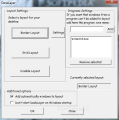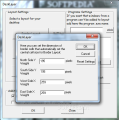DeskLayer has been designed as an easy tool to help you organize the application windows on your desktop screen in a comfortable manner, without overlapping them. It can exploit the free space automatically or at a push of a shortcut.
Microsoft has made great progress with regards to the productivity of the desktop space in Windows, but some still consider that the company is still at the beginning of the road in this sense. So third party solutions are still dependable to expand Windows’s features.
Created to assist you to organize the windows on your desktop, DeskLayer comes with two layout alternatives which can be activated either from the program’s interface or by using keyboard shortcuts.
The freebie is not portable, but installation takes very little to complete. Suffice to keep pressing the “Next” button until the entire process is finishes. You do not have to worry about anything else being pushed on the system because only DeskLayer-related files are installed.
There is no proper interface for the application as the only screen it makes available is the configuration window. It is a simple dialog, which mainly lets you select between two types of layouts, Border and Grid.
The difference between the two should be obvious, given the self-explanatory names, but many users may not quite understand the differences. Activating Border (Ctrl+Alt+B) layout will cause the application windows to be stacked around the desktop’s edges, with the area in the middle being reserved for viewing the active window. In the case of the second layout (activated through Ctrl+Alt+G), its name says it all: objects are aligned into a grid.
Customization of the layouts is no tricky business as the general options let you enable or disable one or another. In the case of Border you also get to define the size of the border cells, in pixels.
Despite being a simple application, DeskLayer sports some other options as well. It features the possibility to create an ignore list, populated with the names of the processes you don’t want to be affected by its organizational abilities. Although this could be a little tricky for plenty of users, the issue can be solved swiftly with a trip to the Processes tab in Windows Task Manager.
Additional options in the configuration panel of the program let you enable automatically adding windows to the selected layout. We recommend you to turn this on if you want all the application windows on the desktop to be automatically arranged the moment you activate one of the two layouts.
Working with DeskLayer can take some time to get used to, but once you’re accustomed with the shortcuts you’ll find the application quite useful. The moment you activate a layout all the windows arrange automatically, giving you an overall perspective of the desktop.
Due to its simplicity, it may look like the application doesn’t have any shortcomings and it is only lacking some features to expand its functionality, but we found a pretty nagging drawback which makes itself noticed when using text processors or editors, but it is not limited to that (Google+ (https://plus.google.com/113483490445626659350/posts) fields are also affected). All the while DeskLayer is running you won’t be able to use the Ctrl + arrows keys combination. We tried this in Microsoft Word, WordPad and Notepad, each time with the same nasty effect.
Keeping DeskLayer enabled on the system does not affect the native Snap feature in Windows 7, so you can use them in tandem. Also, when you take an object out of the defined layout all the others automatically re-arrange to fill in the desktop space. Disabling the layout causes all application windows to fall back in their initial position and snap back to their original size.
The fact that the shortcuts are intuitive and come in a small amount only adds to the value of the application, making it easy to control only through the use of keyboard. Even if it is a simple application, through its purpose of lending a hand to manipulate a larger amount of application windows, DeskLayer is addressing the more seasoned users.
The shortcuts triggering the actions are intuitive enough and easy to remember. Once a layout is enabled all application windows on the desktop auto-arrange themselves. Snap feature in Windows remains unaffected by DeskLayer’s organizational skills and two can function together with no problem. When the layout is disabled all application windows return to their original state and position on the screen. Ctrl + Arrow key combination has no effect for as long as DeskLayer process is running, even if no layout is enabled. However, there are some side-effects to using it, as we’ve learned that some key combinations no longer work on the system with DeskLayer running.
The Good
The Bad
The Truth
 14 DAY TRIAL //
14 DAY TRIAL // 



